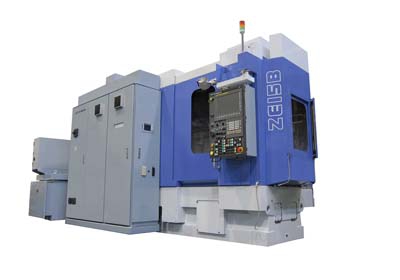
Mitsubishi Heavy Industries Ltd. (MHI) has developed a new gear grinding machine, the ZE15B suitable for volume production of gears up to 150 millimeters in diameter. The machine's high-speed and high-accuracy machining capability will enable further enhancement of productivity, coupled with shorter time not used in machining operation, such as time required for workpiece changes. While primarily focusing on the automobile industry, MHI aims for expanded business by offering the ZE15B to a broad industrial market.
The ZE15B offers even greater volume production capability than the company's ZE15A gear grinding machine, which has earned a favorable reputation in the market since its introduction in 2004. In response to user demand for further space saving, installation space has been reduced by 10 percent compared to the ZE15A, to 3,980mm in width and 4,000mm in depth.
The ZE15B is equipped with a newly developed workpiece changer that shortens the time required for changeover; the twin tailstock model reduces non-operational time to just five seconds. Shorter high-efficiency grinding has been realized by increasing machine rigidity and adopting a 30 percent faster grinding wheel speed: 6,000 revolutions per minute (rpm) at maximum.
For the dresser unit, which functions to maintain the shape and sharpness of the grinding wheel, a new high-speed, high-rigidity device was developed. With these improvements, the new ZE15B is now able to accommodate multiple thread dressers and tooth root grinding while simultaneously reducing dressing time. By automating tooth meshing work required after grinding wheel and dresser changes, operability of the machine has also been enhanced.
To accommodate complex tooth face shapes, the ZE15B is equipped with functions to correct tooth profiles and modify biased flank shapes, i.e. tooth surface torsion.
Contact Details
Related Glossary Terms
- dressing
dressing
Removal of undesirable materials from “loaded” grinding wheels using a single- or multi-point diamond or other tool. The process also exposes unused, sharp abrasive points. See loading; truing.
- grinding
grinding
Machining operation in which material is removed from the workpiece by a powered abrasive wheel, stone, belt, paste, sheet, compound, slurry, etc. Takes various forms: surface grinding (creates flat and/or squared surfaces); cylindrical grinding (for external cylindrical and tapered shapes, fillets, undercuts, etc.); centerless grinding; chamfering; thread and form grinding; tool and cutter grinding; offhand grinding; lapping and polishing (grinding with extremely fine grits to create ultrasmooth surfaces); honing; and disc grinding.
- grinding machine
grinding machine
Powers a grinding wheel or other abrasive tool for the purpose of removing metal and finishing workpieces to close tolerances. Provides smooth, square, parallel and accurate workpiece surfaces. When ultrasmooth surfaces and finishes on the order of microns are required, lapping and honing machines (precision grinders that run abrasives with extremely fine, uniform grits) are used. In its “finishing” role, the grinder is perhaps the most widely used machine tool. Various styles are available: bench and pedestal grinders for sharpening lathe bits and drills; surface grinders for producing square, parallel, smooth and accurate parts; cylindrical and centerless grinders; center-hole grinders; form grinders; facemill and endmill grinders; gear-cutting grinders; jig grinders; abrasive belt (backstand, swing-frame, belt-roll) grinders; tool and cutter grinders for sharpening and resharpening cutting tools; carbide grinders; hand-held die grinders; and abrasive cutoff saws.
- grinding wheel
grinding wheel
Wheel formed from abrasive material mixed in a suitable matrix. Takes a variety of shapes but falls into two basic categories: one that cuts on its periphery, as in reciprocating grinding, and one that cuts on its side or face, as in tool and cutter grinding.






